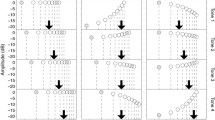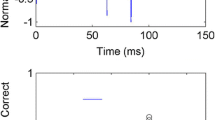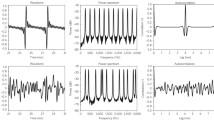Abstract
The octave illusion (Deutsch, 1974) is a well-known auditory illusion elicited by presenting a dichotic sequence of two tones separated by an octave during which the high and low tones alternate between both ears. This illusion engages an important mechanism of auditory perception, which is pitch perception. Previous studies used central frequencies of the useful musical spectrum to elicit the illusion. However, these studies did not cover part of that spectrum where musical pitch perception decreases (below 200 and above 1600 Hz). The present study aimed to investigate how the relative frequency distribution of percepts changes across a greater proportion of the musical scale to better understand the influence of pitch on illusion perception. Participants were presented with 7 pairs of frequencies from 40–80 Hz to 2000–4000 Hz and had to select a choice (octave, simple, complex) corresponding to their perception. When using pairs of stimuli towards the upper and lower boundaries of the selected range: (1) distributions of percepts significantly differ from the classic 400–800 Hz, (2) the octave percept was reported less frequently, particularly at very low frequencies. Results from this study revealed that the illusion perception differs significantly at the low and high limits of the musical spectrum where reduced accuracy of pitch perception is known to occur. These results support past studies who investigated pitch perception. Furthermore, these results support the model proposed by Deutsch where pitch perception is one of the central frameworks of illusion perception.


Similar content being viewed by others
References
Attneave, F., & Olson, R. K. (1971). Pitch as a medium: a new approach to psychophysical scaling. The American journal of psychology, 147–166.
Besson, M., Schön, D., Moreno, S., Santos, A., & Magne, C. (2007). Influence of musical expertise and musical training on pitch processing in music and language. Restorative Neurology and Neuroscience, 25(3–4), 399–410.
Biasutti, M. (1997). Sharp low-and high-frequency limits on musical chord recognition. Hearing Research, 105(1–2), 77–84. https://doi.org/10.1016/S0378-5955(96)00205-5
Brancucci, A., Padulo, C., & Tommasi, L. (2009). “Octave illusion” or “Deutsch’s illusion”? Psychological Research Psychologische Forschung, 73(3), 303–307. https://doi.org/10.1007/s00426-008-0153-7
Brancucci, A., Padulo, C., Franciotti, R., Tommasi, L., & Della Penna, S. (2018). Involvement of ordinary what and where auditory cortical areas during illusory perception. Brain Structure and Function, 223(2), 965–979. https://doi.org/10.1007/s00429-017-1538-4
Bregman, A. S. (1994). Auditory scene analysis: The perceptual organization of sound. MIT Press. https://doi.org/10.7551/mitpress/1486.001.0001
Bregman, A. S., & Steiger, H. (1980). Auditory streaming and vertical localization: Interdependence of “what” and “where” decisions in audition. Perception & Psychophysics, 28(6), 539–546. https://doi.org/10.3758/BF03198822
Brennan, D., & Stevens, C. (2002). Specialist musical training and the octave illusion: analytical listening and veridical perception by pipe organists. Acta Psychologica, 109(3), 301–314. https://doi.org/10.1016/S0001-6918(01)00063-4
Chambers, C. D., Mattingley, J. B., & Moss, S. A. (2002). The octave illusion revisited: suppression or fusion between ears? Journal of Experimental Psychology: Human Perception and Performance, 28(6), 1288–1302. https://doi.org/10.1037/0096-1523.28.6.1288
Chambers, C. D., Mattingley, J. B., & Moss, S. A. (2004a). Reconsidering evidence for the suppression model of the octave illusion. Psychonomic Bulletin & Review, 11(4), 642–666. https://doi.org/10.3758/BF03196617
Chambers, C. D., Mattingley, J. B., & Moss, S. A. (2004b). The suppression model remains unsound: A reply to Deutsch. Psychonomic Bulletin & Review, 11(4), 677–680. https://doi.org/10.3758/BF03196619
Champely, S. (2020). pwr: Basic Functions for Power Analysis. R package, version 1.3–0, URL: https://CRAN.R-project.org/package=pwr
Cherry, E. C. (1953). Some experiments on the recognition of speech, with one and with two ears. The Journal of the Acoustical Society of America, 25(5), 975–979. https://doi.org/10.1121/1.1907229
Deutsch, D. (1974a). An auditory illusion. The Journal of the Acoustical Society of America., 55, S18. https://doi.org/10.1121/1.1919587
Deutsch, D. (1974b). An auditory illusion. Nature, 251(5473), 307–309. https://doi.org/10.1038/251307a0
Deutsch, D. (1975). Musical illusions. Scientific American, 233(4), 92–105.
Deutsch, D. (1978). Lateralization by frequency for repeating sequences of dichotic 400 Hz and 800 Hz tones. The Journal of the Acoustical Society of America, 63, 184–186. https://doi.org/10.1121/1.381710
Deutsch, D. (1980a). Ear dominance and sequential interactions. Journal of the Acoustical Society of America, 67(1), 220–228
Deutsch, D. (1980b). The octave illusion and the what-where connection. In R. S. Nickerson (ed.), Attention and performance (Vol. VIII, pp. 575–594). Hillsdale, NJ: Erlbaum.
Deutsch, D. (1981). The octave illusion and auditory perceptual integration. Hearing Research and Theory, 1(99), 142.
Deutsch, D. (1983). The octave illusion in relation to handedness and familial handedness background. Neuropsychologia, 21(3), 289–293.
Deutsch, D. (1988). Lateralization and sequential relationships in the octave illusion. The Journal of the Acoustical Society of America, 83(1), 365–369. https://doi.org/10.1121/1.396249
Deutsch, D. (2004a). The octave illusion revisited again. Journal of Experimental Psychology: Human Perception and Performance, 30(2), 355. https://doi.org/10.1037/0096-1523.30.2.355
Deutsch, D. (2004b). Reply to “Reconsidering evidence for the suppression model of the octave illusion”, by CD Chambers, JB Mattingley, and SA Moss. Psychonomic Bulletin & Review, 11(4), 667–676. https://doi.org/10.3758/BF03196618
Deutsch, D., & Roll, P. L. (1976). Separate “what” and “where” decision mechanisms in processing a dichotic tonal sequence. Journal of Experimental Psychology: Human Perception and Performance, 2(1), 23. https://doi.org/10.1037/0096-1523.2.1.23
Fastl, H., & Zwicker, E. (2007). Psychoacoustics. Springer.
Henning, G. B. (1966). Frequency discrimination of random-amplitude tones. The Journal of the Acoustical Society of America, 39(2), 336–339. https://doi.org/10.1121/1.1939478
Herholz, S. C., & Zatorre, R. J. (2012). Musical training as a framework for brain plasticity: behavior, function, and structure. Neuron, 76(3), 486–502. https://doi.org/10.1016/j.neuron.2012.10.011
Horbach, M., Verhey, J. L., & Hots, J. (2018). On the pitch strength of bandpass noise in normal-hearing and hearing-impaired listeners. Trends in Hearing., 22, 2331216518787067. https://doi.org/10.1177/2331216518787067
Houtsma, A. J., & Goldstein, J. L. (1972). The central origin of the pitch of complex tones: evidence from musical interval recognition. The Journal of the Acoustical Society of America, 51(2B), 520–529. https://doi.org/10.1121/1.1912873
Jonas Brännström, K., & Nilsson, P. (2011). Octave illusion elicited by overlapping narrowband noises. The Journal of the Acoustical Society of America, 129(5), 3213–3220. https://doi.org/10.1121/1.3571425
Lamminmäki, S., & Hari, R. (2000). Auditory cortex activation associated with octave illusion. NeuroReport, 11(7), 1469–1472.
McClurkin, R. H., & Hall, J. W., III. (1981). Pitch and timbre in a two-tone dichotic auditory illusion. The Journal of the Acoustical Society of America, 69(2), 592–594. https://doi.org/10.1121/1.385376
Oehler, M., & Reuter, C. (2013). The octave illusion and handedness: A replication of Deutsch’s 1974 study. Musicae Scientiae, 17(3), 277–289.
R Core Team. (2022). R: A language and environment for statistical computing. R Foundation for Statistical Computing, Vienna, Austria. URL: https://www.R-project.org/
Rea, L. M., & Parker, R. A. (1992). Designing and conducting survey research. Jossey-Bass.
Ross, J., Tervaniemi, M., & Näätänen, R. (1996). Neural mechanisms of the octave illusion: electrophysiological evidence for central origin. NeuroReport, 8(1), 303–306. https://doi.org/10.1097/00001756-199612200-00060
Shepard, R. N. (1964). Circularity in judgments of relative pitch. The Journal of the Acoustical Society of America, 36(12), 2346–2353. https://doi.org/10.1121/1.1919362
Shower, E. G., & Biddulph, R. (1931). Differential pitch sensitivity of the ear. The Journal of the Acoustical Society of America, 3(2A), 275–287. https://doi.org/10.1121/1.1915561
Tanaka, K., Kurasaki, H., & Kuriki, S. (2018). Neural representation of octave illusion in the human cortex revealed with functional magnetic resonance imaging. Hearing Research, 359, 85–90. https://doi.org/10.1016/j.heares.2018.01.001
Wever, E. G., & Wedell, C. H. (1941). Pitch discrimination at high frequencies. Psychological Bulletin, 38, 727.
Funding
This research was funded by CERVO Brain Research Center (grant number 102099).
Author information
Authors and Affiliations
Contributions
AW, FC and AS: designed and performed the experiment. AW, FC, LC and AS: wrote the manuscript. All the authors discussed the results and revised the manuscript.
Corresponding author
Ethics declarations
Conflict of interest
No conflicts of interest, financial or otherwise are declared by the authors.
Ethical approval
All the procedures performed in studies involving human participants were in accordance with the ethical standards of the institutional and/or national research committee and with the 1964 Helsinki Declaration and its later amendments or comparable ethical standards.
Informed consent
Informed consent was obtained from all the individual participants included in the study.
Additional information
Publisher's Note
Springer Nature remains neutral with regard to jurisdictional claims in published maps and institutional affiliations.
Rights and permissions
Springer Nature or its licensor (e.g. a society or other partner) holds exclusive rights to this article under a publishing agreement with the author(s) or other rightsholder(s); author self-archiving of the accepted manuscript version of this article is solely governed by the terms of such publishing agreement and applicable law.
About this article
Cite this article
Whittom, A., Couture, F., Chauvette, L. et al. Octave illusion: stimulation frequencies can modulate perception. Psychological Research 87, 2183–2191 (2023). https://doi.org/10.1007/s00426-023-01805-z
Received:
Accepted:
Published:
Issue Date:
DOI: https://doi.org/10.1007/s00426-023-01805-z




